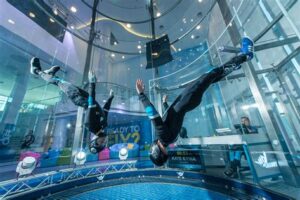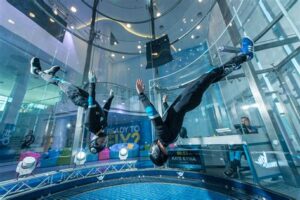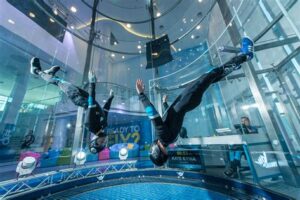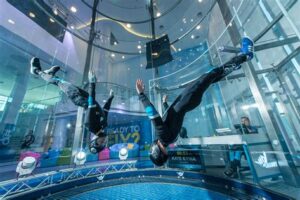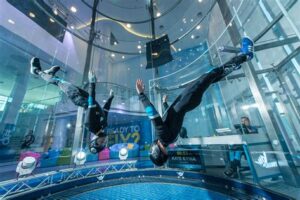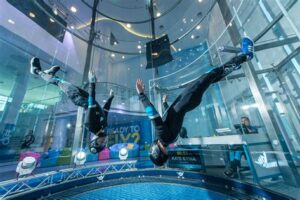Table of Contents
Discover the thrilling world of indoor skydiving and uncover how it works! Experience the sensation of freefalling in a controlled environment as powerful fans simulate the feeling of skydiving. Learn about the physics behind this exhilarating activity and how professional instructors guide you through every step. Find out how to master body positioning, balance, and stability to soar gracefully in the air. Whether you are an adrenaline junkie or simply seeking a unique adventure, indoor skydiving offers an unforgettable experience suitable for all ages and abilities.
Indoor skydiving has revolutionized the way thrill-seekers experience the adrenaline rush of freefalling through the sky. Gone are the days of having to jump out of an airplane thousands of feet in the air – now, you can defy gravity and feel the sensation of flying right inside a controlled environment. But how does this remarkable feat work? Let’s delve into the intricacies of indoor skydiving and uncover the secrets behind this exhilarating adventure.
Introduction
Indoor skydiving, also known as vertical wind tunnel flying, is an exhilarating activity that simulates the sensation of freefalling through the air. This thrilling experience allows individuals to experience the adrenaline rush of skydiving without jumping from an airplane. In this article, we will explore how indoor skydiving works and the technology behind it.
The Vertical Wind Tunnel
The heart of indoor skydiving is the vertical wind tunnel. This massive structure is designed to generate a powerful column of air that mimics the feeling of freefall. The wind tunnel consists of a large chamber with an upward-facing fan at the bottom, which produces a strong upward airflow.
Freefall Simulation
When you enter the wind tunnel, you’ll be lifted off the ground by the force of the upward-flowing air. This creates a sensation of weightlessness similar to actual skydiving. The wind speed can be adjusted to simulate different levels of freefall, allowing participants to practice various skydiving maneuvers.
Body Positioning
Controlling your body position is key to maintaining stability during indoor skydiving. By adjusting your body angle, you can control your movement within the wind tunnel. Beginners typically start with a basic belly-down position, while more advanced flyers can try more challenging techniques, such as backflips or flying headfirst.
Wind Speed and Stability
The wind speed within the tunnel is carefully controlled to provide a stable and safe environment for indoor skydiving. Too much airflow can make it difficult to maintain stability, while too little can limit your ability to perform maneuvers. Skilled instructors monitor and adjust the wind speed throughout your flight to ensure optimal conditions.
Training and Safety
Prior to your indoor skydiving experience, you will undergo a comprehensive training session to learn the basics of body control and safety procedures. Instructors will guide you on how to enter and exit the wind tunnel, proper body positioning, and hand signals used to communicate inside the tunnel. This training ensures a safe and enjoyable experience for all participants.
Equipment Used
Indoor skydiving requires specific equipment to ensure safety and enhance the experience. Participants wear a jumpsuit made of wind-resistant material, which helps maintain stability and protects against windburn. Additionally, a helmet, goggles, and earplugs are provided to protect against any potential risks associated with flying indoors.
Benefits of Indoor Skydiving
Indoor skydiving offers several benefits beyond the adrenaline rush. It provides a controlled environment for beginners to learn the basics of skydiving before attempting outdoor jumps. It also serves as a valuable training tool for experienced skydivers to refine their skills and try new maneuvers. Furthermore, indoor skydiving offers a fun and unique activity for individuals of all ages and fitness levels.
Indoor Skydiving Centers
Indoor skydiving centers have gained popularity worldwide, offering individuals the opportunity to experience the thrill of freefalling without the need for an airplane or perfect weather conditions. These centers often provide professional instructors, state-of-the-art wind tunnels, and a safe environment for both beginners and experienced flyers.
The Future of Indoor Skydiving
As technology continues to advance, the future of indoor skydiving looks promising. Innovations in wind tunnel design and engineering are constantly improving the indoor skydiving experience, making it even more realistic and immersive. With ongoing developments and increasing accessibility, indoor skydiving is set to become an increasingly popular adventure sport.
Conclusion
Indoor skydiving offers an exhilarating and safe alternative to traditional skydiving. By replicating the sensation of freefall with the help of vertical wind tunnels, individuals can experience the thrill of skydiving in a controlled environment. Whether you’re a beginner looking to learn the basics or an experienced skydiver seeking to refine your skills, indoor skydiving provides an exciting adventure for all.
Introduction to Indoor Skydiving: Experience the Thrill of Skydiving Indoors
Indoor skydiving offers the thrilling experience of skydiving without the need to jump out of an airplane. Using a vertical wind tunnel and advanced airflow technology, participants can enjoy the sensation of freefalling in a controlled and safe indoor environment.
The Vertical Wind Tunnel: The Engine Behind Indoor Skydiving
At the heart of indoor skydiving is the vertical wind tunnel, a powerful machine that generates a vertical column of air. This wind tunnel allows participants to experience the same forces and sensations encountered during a real skydive, simulating the feeling of flying through the air.
Flight Gear and Safety Measures: Preparing for the Indoor Skydiving Experience
Before taking flight, participants are equipped with specialized flight gear, including a jumpsuit, helmet, goggles, and earplugs. Additionally, expert instructors provide a comprehensive safety briefing to ensure everyone understands the proper body positioning and hand signals necessary for a safe and enjoyable flight.
Body Positioning and Stability: Mastering the Art of Indoor Flight
Achieving the perfect body position is key to stabilizing oneself in the wind tunnel and maintaining control during the flight. Instructors guide participants on how to position their bodies, emphasizing the importance of relaxed limbs and correct posture to maximize their flight experience.
Controlling Altitude and Movement: Ascending and Descending in the Wind Tunnel
Just like in real skydiving, participants can control their altitude and movement while indoors. By adjusting their body positions and making subtle hand and arm movements, they can ascend, descend, turn, and even perform basic tricks in the wind tunnel under the guidance of experienced instructors.
The Role of Instructors: Mentoring and Assisting Participants in Indoor Skydiving
Trained instructors play a crucial role in the indoor skydiving experience. They supervise participants throughout their flight, providing real-time feedback and guidance to help them improve their flight skills and ensure their safety at all times.
Progression and Skill Development: Advancing in Indoor Skydiving Abilities
Indoor skydiving offers a progressive learning environment, allowing participants to advance their skills over time. As they become more comfortable and proficient in the wind tunnel, individuals can learn advanced maneuvers, such as 360-degree turns, flips, and even formation flying with other participants.
Accessibility and Family-Friendly Fun: Indoor Skydiving for Everyone
One of the great advantages of indoor skydiving is its accessibility to people of all ages and physical abilities. Whether you are an adrenaline junkie, a thrill-seeking family, or someone looking to try a unique and exhilarating activity, indoor skydiving offers a safe and enjoyable experience that can be shared with friends and loved ones.
In the exhilarating world of extreme sports, indoor skydiving has emerged as a popular and thrilling activity for adventure enthusiasts. This unique experience replicates the sensation of freefalling through the sky, but within the controlled environment of an indoor wind tunnel. Let us delve into the fascinating world of indoor skydiving and explore how it works.
1. State-of-the-art technology:
Indoor skydiving utilizes cutting-edge technology in the form of vertical wind tunnels that generate powerful air currents. These wind tunnels consist of a tall, cylindrical chamber with a powerful fan located at the top. The fan propels air downwards at high speeds, creating a vertical column of air that simulates the feeling of freefalling.
2. Airflow management:
The key to successful indoor skydiving lies in the precise management of airflow within the wind tunnel. The fan at the top of the tunnel draws air from outside, compresses it, and pushes it down through the chamber. The airflow is carefully regulated to achieve the desired speed and consistency, ensuring a safe and enjoyable experience for participants.
3. Body position and technique:
Participants in indoor skydiving are required to adopt specific body positions and techniques to maintain stability and control within the wind tunnel. By adjusting their posture and manipulating their limbs, skydivers can maneuver and perform various aerial maneuvers, such as spins, flips, and turns. Skilled instructors guide participants on the correct techniques to maximize their enjoyment and safety.
4. Safety measures:
Indoor skydiving facilities prioritize safety and employ various measures to ensure a risk-free experience. Participants are provided with specialized flight suits, helmets, goggles, and earplugs to protect them from the powerful air currents. Additionally, trained instructors closely monitor each participant during their flight, providing guidance and assistance when necessary.
5. Accessibility and versatility:
One of the major advantages of indoor skydiving is its accessibility to people of all ages and physical abilities. Unlike traditional skydiving, which requires extensive training, expensive equipment, and favorable weather conditions, indoor skydiving offers a controlled and controlled environment that is available year-round. This makes it an ideal activity for individuals seeking an adrenaline rush or those who wish to experience the thrill of flight without the associated risks.
In conclusion, indoor skydiving offers a thrilling and safe way to experience the sensation of freefalling through the sky. Through the use of state-of-the-art technology, precise airflow management, and expert instruction, participants can enjoy an exhilarating adventure in a controlled environment. With accessibility and safety at its core, indoor skydiving has become a popular choice for adrenaline seekers worldwide.
Thank you for taking the time to visit our blog and learn more about the fascinating world of indoor skydiving. We hope that this article has provided you with valuable insights into how indoor skydiving works and why it has become such a popular and thrilling activity for people of all ages and skill levels.
Indoor skydiving, also known as bodyflight, offers an exhilarating experience that simulates the sensation of freefalling through the air without the need for an aircraft or parachute. As mentioned in our previous paragraphs, the key to this gravity-defying adventure lies in a vertical wind tunnel. This state-of-the-art technology generates a powerful updraft of air, allowing individuals to float effortlessly within a controlled environment.
One of the most remarkable aspects of indoor skydiving is its accessibility. Unlike traditional skydiving, which requires extensive training and the courage to jump out of an airplane, indoor skydiving is suitable for people of all fitness levels and ages. Whether you are a seasoned skydiver looking to improve your skills or simply seeking an adventurous and unique activity, indoor skydiving offers a safe and thrilling experience for everyone.
In conclusion, we hope that this article has given you a comprehensive understanding of how indoor skydiving works. The combination of advanced wind tunnel technology and skilled instructors ensures a safe and enjoyable experience for all participants. So why not challenge yourself and take the leap (pun intended) into the world of indoor skydiving? Whether you are seeking an adrenaline rush, a new hobby, or simply a memorable day out with friends and family, indoor skydiving is sure to leave you with unforgettable memories and a newfound appreciation for the wonders of flight.
Thank you again for visiting our blog, and we look forward to welcoming you to the thrilling world of indoor skydiving soon. Safe travels and happy flying!
.
People Also Ask: Indoor Skydiving How It Works
1. What is indoor skydiving and how does it work?
Indoor skydiving, also known as bodyflight or vertical wind tunnel flying, is a thrilling recreational activity that simulates the experience of freefalling through the sky. It involves entering a vertical wind tunnel, which generates a powerful upward airflow, allowing participants to float on a cushion of air. The wind tunnel’s design creates a controlled environment where individuals can experience the sensation of skydiving without the need for an aircraft or parachute.
2. How does the wind tunnel generate the airflow for indoor skydiving?
The wind tunnel features a large, powerful fan at the top, which draws in air from the surrounding environment. This air is then accelerated and directed downwards into the flight chamber. As the air flows through the chamber, it encounters a series of diffusers, which help to evenly distribute the airflow and create a smooth column of air. The bottom of the chamber contains a trampoline-like netting or mesh floor, which serves as a platform for participants to float on the updraft.
3. Do I need any prior experience or training to try indoor skydiving?
No prior experience or training is necessary to try indoor skydiving. Before your flight, you will receive a comprehensive safety briefing from experienced instructors who will guide you throughout the experience. They will teach you the correct body positions and hand signals to ensure a safe and enjoyable flight. The wind tunnel environment allows for gentle adjustments in airflow, making it suitable for all ages and fitness levels.
4. Is indoor skydiving safe?
Indoor skydiving is considered a safe adventure activity when conducted in a properly maintained and regulated wind tunnel facility. The equipment used, such as flight suits, goggles, and helmets, is designed to provide protection and comfort. Trained instructors are present at all times to monitor participants and ensure their safety. Additionally, the wind tunnel’s controlled environment minimizes the risks associated with traditional outdoor skydiving, such as weather conditions or parachute malfunctions.
5. What does it feel like to fly in a wind tunnel?
Flying in a wind tunnel feels like floating on a cushion of air. As the powerful airflow lifts you off the ground, you experience the sensation of weightlessness and freedom similar to that of actual skydiving. The feeling can be both exhilarating and surprisingly calming as you learn to control your body position and movements within the wind tunnel. Many people find indoor skydiving to be an unforgettable and addictive experience.
Remember, if you have any specific concerns or questions about indoor skydiving, it is always best to consult with the professionals at the wind tunnel facility you plan to visit. They will provide you with accurate information and address any individual inquiries you may have.

